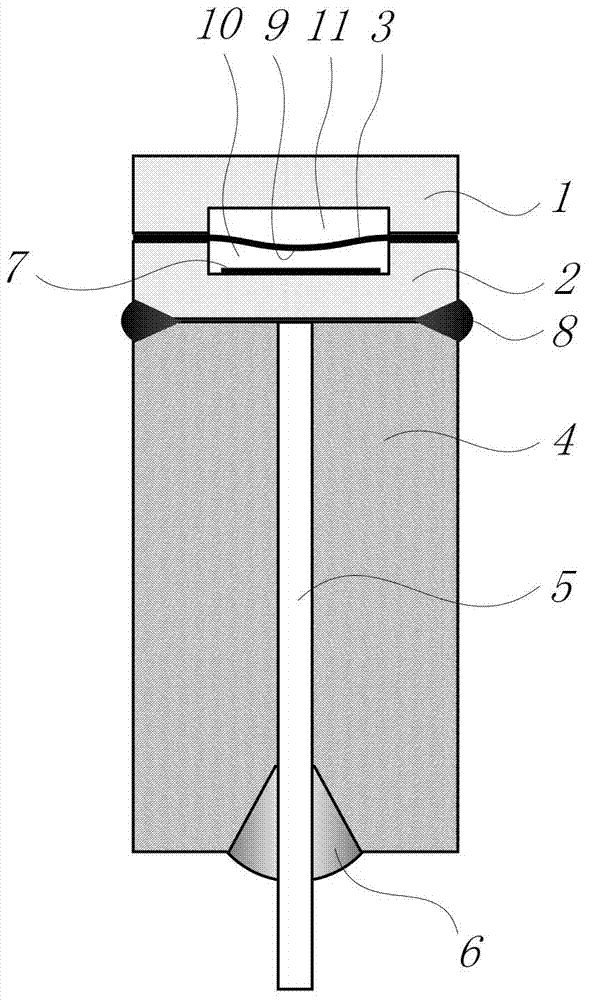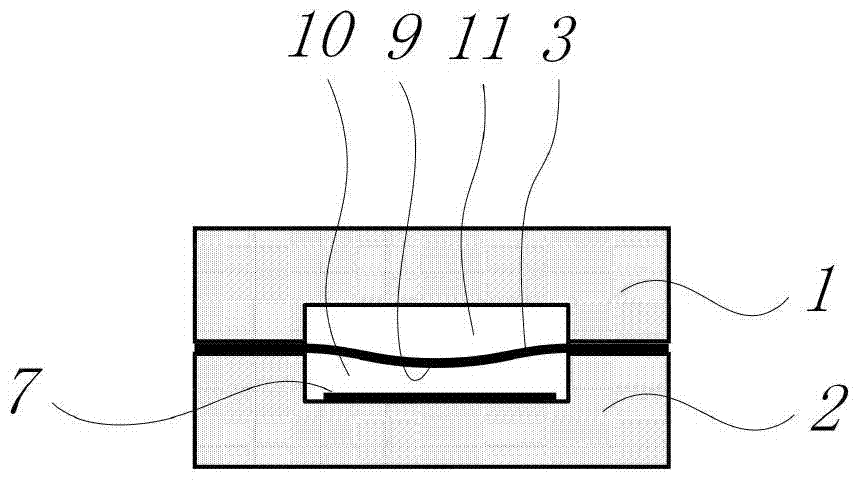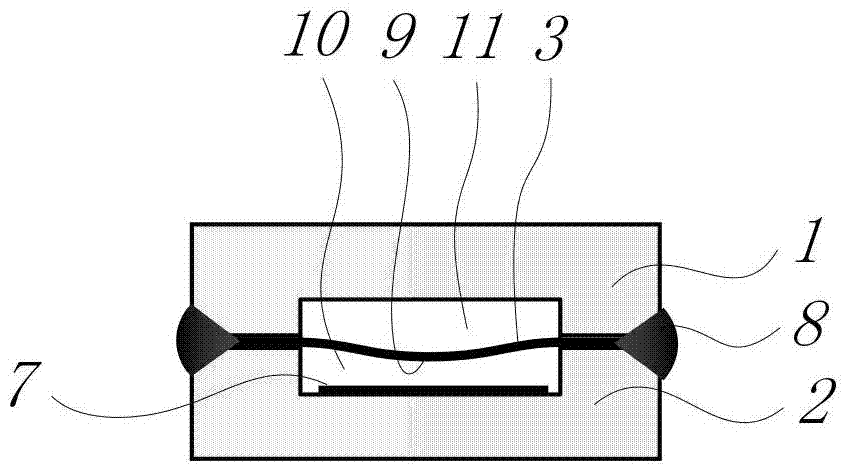Fiber optic temperature sensor based on sealed micro cavity gas thermal effect and manufacturing method of fiber optic temperature sensor
An optical fiber temperature and sensor technology, applied in the direction of thermometers, thermometers, instruments, etc. with physical/chemical changes, can solve the problems of difficulty in mass production, the limitation of the degree of freedom of temperature sensitivity design, and achieve good consistency, low cost, The effect of large design freedom
- Summary
- Abstract
- Description
- Claims
- Application Information
AI Technical Summary
Problems solved by technology
Method used
Image
Examples
Embodiment 1
[0033] Embodiment 1: The structure and manufacture of an optical fiber temperature sensor based on the gas thermal effect of a closed microcavity.
[0034] like figure 1 As shown, the sensor structure includes a sensor head chip, a sensor body 4 and an optical fiber 5 . figure 2 Shown is a three-layer sensor head chip manufactured by anodic bonding process, which includes a first Pyrex glass wafer 1 , a single crystal silicon wafer 3 and a second Pyrex glass wafer 2 . The specific production process is: using HF and HNO 3 The solution etches out the shallow pit array on the Pyrex glass wafer 2 as the cavity of the Fapo microcavity 10, and plating Ta at the bottom of the shallow pit 2 o 5 reflective film7. Under the condition of vacuum environment (that is, 0kpa), the second Pyrex glass wafer with the shallow pit array etched and the monocrystalline silicon wafer 3 are fused by anodic bonding to form the Fab microcavity 10, wherein Ta 2 o 5 The reflective film 7 and the ...
Embodiment 2
[0037] Example 2: Temperature measurement process of optical fiber temperature sensor based on thermal effect of airtight microcavity
[0038] Figure 4 Shown is a schematic diagram of the sensor temperature measurement principle. The first Pyrex glass wafer 1 corrodes the shallow pit and the monocrystalline silicon wafer 3 to form a Fapp microcavity 10, and the first Pyrex glass wafer 1 etches the shallow pit array and the monocrystalline silicon wafer 3 to form an air chamber. microcavity11. The single crystal silicon wafer 3 is sandwiched between the Fapp microcavity 10 and the air microcavity 11 . By separately controlling the production environment pressures of the two cavities, different molar quantities of air molecules 12 exist in the two cavities, which is visually manifested as a fixed pressure difference P in the micro cavities on both sides of the single crystal silicon wafer 3 . Therefore, under the action of the pressure difference, the single crystal silicon ...
Embodiment 3
[0046] Example 3: Optical fiber temperature sensor experiment and microcavity cavity length demodulation based on the thermal effect of airtight microcavity
[0047] The cavity length demodulation system based on low-coherence interference demodulation is shown in Fig. Figure 5 shown. The process of cavity length demodulation is: the light emitted by the broadband light source 17 (the broadband light source is a white light LED, xenon lamp or halogen lamp) is coupled into the transmission fiber 19, and enters a 3dB 2×1 coupler 18 or an optical circulator, From the other end, it is incident on the sensor 20 through the transmission fiber 19 . The light signal reflected by the sensor 20 passes through the 3dB 2×1 coupler 18 again and then enters the Fab cavity length demodulator 21 to obtain the demodulated low-coherence interference original signal 24, as shown in Image 6 shown. The low-coherence interference original signal 24 is transmitted to the computer 23 through the...
PUM
| Property | Measurement | Unit |
|---|---|---|
| Diameter | aaaaa | aaaaa |
| Depth | aaaaa | aaaaa |
Abstract
Description
Claims
Application Information
 Login to View More
Login to View More - R&D
- Intellectual Property
- Life Sciences
- Materials
- Tech Scout
- Unparalleled Data Quality
- Higher Quality Content
- 60% Fewer Hallucinations
Browse by: Latest US Patents, China's latest patents, Technical Efficacy Thesaurus, Application Domain, Technology Topic, Popular Technical Reports.
© 2025 PatSnap. All rights reserved.Legal|Privacy policy|Modern Slavery Act Transparency Statement|Sitemap|About US| Contact US: help@patsnap.com



